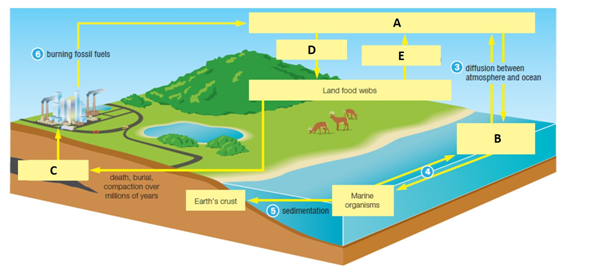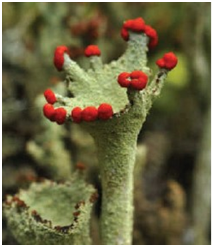Correct Answer
Multiple Choice
The cowbird chick with its foster parent exemplifies an example of ____.
A) commensalism
B) brood parasitism
C) competition
D) mutualism
E) parasitoidism
G) A) and C)
Correct Answer

verified
Correct Answer
verified
Multiple Choice
Which is a characteristic of parasites?
A) They are indiscriminate in their choice of host.
B) They inflict serious injury and kill their host.
C) Some reside inside their host, whereas others live outside their host.
D) Parasitic hosts are always animals.
E) They rarely harm their host.
G) C) and D)
Correct Answer

verified
Correct Answer
verified
Multiple Choice
Light energy from the sun is captured by photosynthesis as ____.
A) heat energy in chemical bonds
B) energy in chemical bonds
C) chemical energy lost to the environment
D) kinetic energy in chemical bonds
E) conserved energy
G) B) and D)
Correct Answer

verified
Correct Answer
verified
Multiple Choice
The niche of an earthworm in an ecosystem is as a(n) ____.
A) producer
B) consumer
C) detritivore
D) decomposer
E) parasite
G) B) and C)
Correct Answer

verified
Correct Answer
verified
Multiple Choice
Most of the Earth's phosphorous is in the form of ____.
A) phosphoric acid
B) elemental phosphorous
C) phosphate
D) phosphorous cations
E) carbonate
G) B) and D)
Correct Answer

verified
Correct Answer
verified
Matching
Match the trophic category to the correct description.
Correct Answer
Matching
Examine the figure below of the carbon cycle. Match each term with the concept to which it best corresponds.

Correct Answer
Multiple Choice
Considering the traditional view of ecological succession, which plant would most likely be a pioneer species in a primary succession event?
A) an oak tree that produces acorns dispersed by squirrels
B) a snapdragon flower pollinated by bees
C) a dandelion that produces seeds asexually, which are dispersed by the wind
D) a perennial species such as Douglas fir trees
E) a birch tree
G) None of the above
Correct Answer

verified
Correct Answer
verified
Multiple Choice
An energy pyramid is ____.
A) a demonstration of the first law of thermodynamics
B) a representation of the decline in available energy as it travels through the trophic levels
C) fundamentally different from the pyramid of biomass and the pyramid of numbers
D) a demonstration of the interactions between species in a community
E) a representation of an ecosystem's diversity
G) A) and E)
Correct Answer

verified
Correct Answer
verified
Multiple Choice
Nitrogen gas is first converted into _____ by certain_____ before it enters the land nitrogen cycle.
A) nitrate; bacteria
B) ammonium; bacteria
C) elemental nitrogen; bacteria
D) nitrate; bacteria and fungi
E) ammonium; bacteria and fungi
G) B) and C)
Correct Answer

verified
Correct Answer
verified
Multiple Choice
The warming action on Earth's atmosphere is referred to as ____.
A) respiration accumulation
B) the greenhouse effect
C) the smog problem
D) the blanket phenomenon
E) ozone depletion
G) D) and E)
Correct Answer

verified
Correct Answer
verified
Multiple Choice
The lichen shown here is an example of ____.

A) competition
B) parasitism
C) predation
D) commensalism
E) mutualism
G) A) and D)
Correct Answer

verified
Correct Answer
verified
Multiple Choice
Carbon dioxide in the atmosphere ____.
A) is destroying the ozone layer
B) has dramatically increased in the last few decades
C) is one of the prime reasons for acid depositions
D) is a waste gas produced by respiration and has no biological use
E) can change spontaneously to carbon monoxide in sunlight
G) A) and E)
Correct Answer

verified
Correct Answer
verified
Multiple Choice
In an Arctic food web, the organisms in these pictures represent the ____.

A) second trophic level
B) secondary consumers
C) first trophic level
D) primary consumers
E) third trophic level
G) A) and C)
Correct Answer

verified
Correct Answer
verified
Multiple Choice
Secondary succession can occur ____.
A) after a fire
B) on a new sand dune
C) on bare rock
D) immediately after the formation of an artificial lake
E) on a glacier
G) A) and C)
Correct Answer

verified
Correct Answer
verified
Multiple Choice
The interaction in which one species benefits and the second species is neither harmed nor benefited is ____.
A) mutualism
B) parasitism
C) commensalism
D) competition
E) predation
G) B) and C)
Correct Answer

verified
Correct Answer
verified
Multiple Choice
Where is most of the Earth's phosphate found?
A) ocean water
B) aquifers
C) the atmosphere
D) rocks and sediments
E) plants
G) B) and D)
Correct Answer

verified
Correct Answer
verified
Multiple Choice
Red imported fire ants (RIFAs) disrupt natural communities by ____.
A) congregating inside electrical equipment
B) competing with native ant populations
C) stinging humans with deadly venom
D) disrupting pasture land
E) killing Texas horned lizards
G) A) and B)
Correct Answer

verified
Correct Answer
verified
Multiple Choice
The monarch butterfly is poisonous to birds; therefore, birds avoid eating them. Viceroy butterflies look very similar to monarch butterflies, but are not poisonous. Because they look like monarch butterflies, birds also do not eat viceroy butterflies. This is an example of ____.
A) resource partitioning
B) competitive exclusion
C) mimicry
D) camouflage
E) commensalism
G) B) and E)
Correct Answer

verified
Correct Answer
verified
Showing 61 - 80 of 100
Related Exams